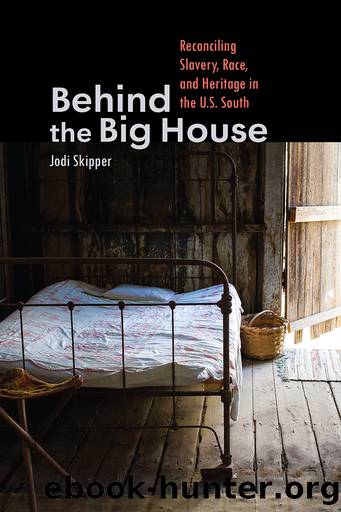Behind the Big House: Reconciling Slavery, Race, and Heritage in the U.S. South by Jodi Skipper

Author:Jodi Skipper
Language: eng
Format: epub
Publisher: University of Iowa Press
Published: 2022-06-15T00:00:00+00:00
Rkhty and Wayne Jones at Gracing the Tableâs 2019 libation ceremony at Hillcrest Cemetery. Photo by Tarondal Phillips.
By 2010, Rkhty and Wayne, her husband, had cofounded the Marshall County African American Living History Association with local historian Sylvester (whom she refers to as Sy) Oliver.30 The group envisioned doing living history and historical research to tell African American stories. They traveled to churches and schools doing living history interpretations of famous Marshall Countians like Belle Caruthers, a former enslaved woman who was candid about her ownersâ abuse in her Works Progress Administration former slave narrative; Hiram Rhodes Revels, the first African American U.S. senator; George Washington Albright, who was born enslaved in Holly Springs and later âentered the Mississippi Senate as a member of the Reconstruction governmentâ; and Memphis businessman, philanthropist, and community activist Robert R. Church Sr., also born in Holly Springs.31 They also did living history interpretations at Annie Lucasâs soul food restaurant on one occasion, and Rkhty reflects on that experience as âan exciting time.â32 Six to eight people reenacted, with about twelve people involved as a whole. Even Andre DeBerry, Holly Springsâs mayor from 2001 to 2013, was involved.
Unfortunately, they were unable to keep the momentum going. The reenactments required research, costuming, and people willing to invest the time and effort. Some participants were more committed than others, notably Holly Springs native Dale DeBerry, who âstayed with them âtil the end.â DeBerry, a master clay craftsman, was key to helping form their brickmaking project, interpreting the experiences of enslaved brickmakers integral to Holly Springsâs antebellum infrastructure. Rkhty researched the brickmaking process and talked with older brickmakers in the city, subsequently compiling a booklet for sale at historic site festivals like the Ames Plantation Heritage Festival near Grand Junction, Tennessee, just about thirty miles northeast of Holly Springs. She thought that short, accessible reading would be a good idea. âWe didnât want to deal with scholars. We just wanted to do this for the people.â33
Rkhty walked around the city looking at bricks. Through that process, she met homeowners like David Person, who advised her that the clay for the bricks came from the building site itself. She had no idea and wanted to share that information with others. She said that even the brickmakers she interviewed, who worked in local kilns, were fascinated by the work of their historical counterparts. Brickmaking was an essential part of an enslaved personâs experiences in antebellum Holly Springs, yet it was a subject rarely discussed in the standard architectural narratives. âI just wanted to make people in Holly Springs proud of what theyâve done. Because itâs not just the bricks, itâs the ironworking, woodworking, itâs so many things, and we havenât started to talk about those other things.â34
On one of her walks, Rkhty had a conversation with David about the slave dwelling on his property. She recalls that he considered turning the dwelling into guest houses, and she suggested that he open it up for tours. Members of the Marshall County
Download
This site does not store any files on its server. We only index and link to content provided by other sites. Please contact the content providers to delete copyright contents if any and email us, we'll remove relevant links or contents immediately.
Hit Refresh by Satya Nadella(9036)
When Breath Becomes Air by Paul Kalanithi(8326)
The Girl Without a Voice by Casey Watson(7821)
A Court of Wings and Ruin by Sarah J. Maas(7648)
Do No Harm Stories of Life, Death and Brain Surgery by Henry Marsh(6887)
Shoe Dog by Phil Knight(5139)
Hunger by Roxane Gay(4869)
The Rules Do Not Apply by Ariel Levy(4842)
A Higher Loyalty: Truth, Lies, and Leadership by James Comey(4840)
Tuesdays with Morrie by Mitch Albom(4685)
Everything Happens for a Reason by Kate Bowler(4677)
The Immortal Life of Henrietta Lacks by Rebecca Skloot(4523)
Millionaire: The Philanderer, Gambler, and Duelist Who Invented Modern Finance by Janet Gleeson(4374)
How to Change Your Mind by Michael Pollan(4288)
All Creatures Great and Small by James Herriot(4228)
The Money Culture by Michael Lewis(4073)
Man and His Symbols by Carl Gustav Jung(4066)
Elon Musk by Ashlee Vance(4024)
Tokyo Vice: An American Reporter on the Police Beat in Japan by Jake Adelstein(3935)
